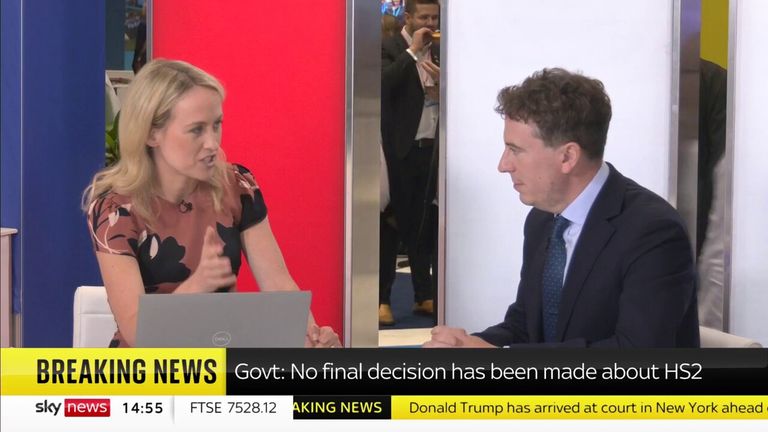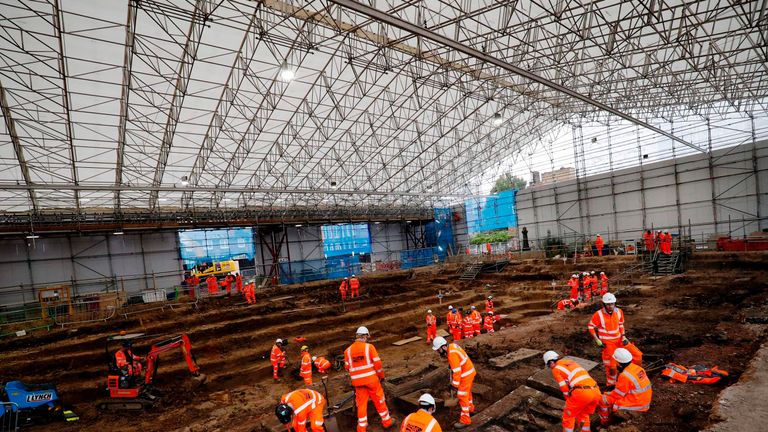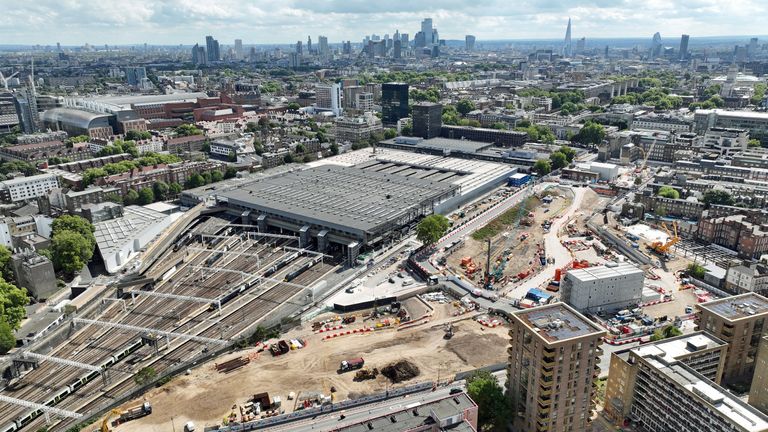HS2 was touted because the UK’s greatest infrastructure venture, supposed to rework public transport between London, the Midlands and the North.
But it’s changing into synonymous with political football, disappointment, delays and spiralling prices.
The newest blow to the venture, as Sky News understands, is the federal government’s intention to axe the rail plans linking Birmingham to Manchester.
This would shrink the route considerably, with passengers solely in a position to go between a station in a west London suburb to Birmingham – moderately than from London Euston to Manchester.
Downing Street denies a last resolution has been made, however a spokesperson didn’t set out which particulars had been improper and didn’t deny {that a} Cabinet assembly could be organized.
Interventions from five regional Labour mayors and quite a few northern companies have completed their greatest to retain the venture in full, however it now seems HS2 is not going to be fulfilled as initially deliberate.
What is HS2 and why had been the plans made?
HS2 was alleged to type 330 miles of high-speed rail community, initially supposed to hyperlink London and the West Midlands, stretching to Birmingham, with an additional section extending to Crewe, Manchester and Leeds within the North.
It was first mooted by the Labour authorities in 2009 and it was hoped the rise in capability could be a lift for connectivity between main cities.
Supporters stated it might allow intercity trains at present operated by Avanti West Coast to be taken off the West Coast Main Line, creating more room for stopping companies and freight trains.
Another enchancment could be lowered journey occasions.
HS2’s inception adopted the event of HS1, the high-speed line between London and Kent connecting the UK to routes on the European continent.
The intention was to run 18 trains an hour in every route to and from London – at speeds of as much as 224mph – in comparison with between two and 6 an hour on Europe’s high-speed railways.
Why is the Manchester leg set to be axed?
The venture has been beset by delays and rising prices, with some estimates now placing the value tag at greater than £180bn, a determine that is repeatedly risen from the 2019 estimate.
In 2019 prices had been put at round £100bn.
According to the Independent, value estimate revealed ditching the northern section may save as much as £34bn.
How a lot was it alleged to value?
The unique invoice – at 2009 costs – was alleged to be £37.5bn.
At the time of the 2010 election, when David Cameron stated his authorities would publish plans for a high-speed rail, £20bn was dedicated for rail infrastructure.
By January 2012, when the broad route of the proposed scheme was in place, this had risen to £32.6bn.
In June 2013, the coalition authorities elevated the general value to £42.6bn and in November 2015, when the figures had been up to date, consistent with inflation, to £55.7bn.
The Department for Transport’s newest estimate in 2021 had spiralled even greater, to between £72bn and £98bn.
But Lord Berkeley, former deputy chairman of the federal government’s unbiased evaluate into the venture, stated it may climb to £107bn.
As of June, the overall spent to date was £24.7bn (at 2019 costs).
Read extra
Ex-minister calls for inquiry into HS2
Rosebank won’t make big difference to economy – but the politics are significant
What was the route going to be?
Stations on the primary section of the road had been meant to be London Euston, Old Oak Common in west London, Birmingham interchange and Birmingham Curzon Street.
There are, nevertheless, issues the London Euston station terminus can be axed as it has been placed on pause as a consequence of spiralling prices.
The line will as a substitute finish in Old Oak Common, requiring passengers to get the Elizabeth Line to central London.
This means it may very well be greater than a decade earlier than high-speed companies cease at Euston, with passengers anticipated as a substitute to journey for half an hour on the Elizabeth Line.
The second section was meant to see trains head northwest to Manchester Airport and Manchester Piccadilly, or use current traces by way of Wigan, Crewe and Stafford.
The route had additionally been deliberate to go northeast from Birmingham in the direction of the East Midlands Hub at Toton.
From there, earlier than the japanese extension was cancelled, the trains had been as a consequence of proceed on the HS2 line to Leeds, with others diverging onto current traces by way of Chesterfield and York.
The unique plans had been:
- Phase 1: London Euston to Birmingham Curzon Street, with intermediate stations at Old Oak Common within the western suburbs and at Birmingham Airport.
- Phase 2a: To lengthen the road from Fradley within the West Midlands to Crewe in Cheshire.
- Phase 2b: Comprised of an japanese leg from the West Midlands to the East Midlands and a western leg from Crewe to Manchester.
How has it modified?
The japanese leg between Birmingham and Leeds was lowered to a spur line that is because of finish within the East Midlands.
In March, it was confirmed development between Birmingham and Crewe could be delayed by two years and that companies might not enter central London till the 2040s.
Transport Secretary Mark Harper introduced work at Euston could be paused for 2 years as prices had been forecast to nearly double to £4.8 billion.
The pause means Old Oak Common, within the capital’s western suburbs, would be the railway’s solely London station when companies to and from Birmingham Curzon Street start between 2029 and 2033.
And the route between Birmingham and Manchester – together with by way of Crewe – is ready to be scrapped.
What will change the Birmingham-Manchester line?
Sky News understands the Department of Transport (DfT) has labored up a package deal of different initiatives – rail, bus and street schemes – which may very well be funded from cash saved by scrapping the Manchester to Birmingham leg of the venture.
An expanded Northern Powerhouse Rail venture linking northern cities and contemporary money for potholes and bus routes may very well be introduced to melt the blow.
Where did all of it start?
In 2009, beneath Labour transport secretary Geoff Hoon, the federal government arrange an organization, HS2 Ltd, to have a look at proposals for a brand new high-speed line.
The following yr, the Department for Transport (DfT) set out plans for a Y-shaped community connecting London and the cities within the North.
Later, beneath the Conservative-Liberal Democrat coalition, it was confirmed that the road could be in-built two phases.
Phase 1 would run from London to the West Midlands, starting in 2026. That’s been pushed again to between 2029 and 2033. Euston Station is just not as a consequence of open till 2035.
Phase 2, extending from the West Midlands to cities within the North, was meant to start out in 2032-33. But that was moved to any time from 2034 and 2041, earlier than selections to scrap it.
Why is HS2 so not on time?
By July 2019, the federal government accepted that the timetable was not possible and has continued to vary opening occasions.
Reasons for the delay included a yr spent revising value and schedule estimates for section 1 and extra time being wanted for development at numerous websites.
In August 2019, the federal government introduced an unbiased evaluate of the programme to advise on whether or not to proceed.
And in March of this yr the federal government introduced extra development could be delayed by two years to economize.
The COVID-19 pandemic in all probability did not assist with progress, both.
In a written ministerial assertion earlier this yr, Transport Secretary Mark Harper stated the federal government is “prioritising HS2’s initial services” between Old Oak Common in west London and Birmingham Curzon Street.
Why have the prices risen a lot?
In one phrase: inflation.
Mr Harper already stated earlier this yr, “we have seen significant inflationary pressure and increased project costs, and so we will rephase construction by two years, with an aim to deliver high-speed services to Crewe and the North West as soon as possible after accounting for the delay in construction”.
A report in January 2020 by the National Audit Office (NAO) – the spending watchdog – stated HS2 Ltd had not accounted for the extent of uncertainty and danger within the plans.
It used a way for calculating how a lot further is perhaps wanted “that was not appropriate for a programme at such an early stage of development”.
Among the elements inflicting greater prices had been commitments to extend the size of tunnelling and to erect noise obstacles.
The NAO stated the federal government and HS2 Ltd had “not adequately managed risks to taxpayer money”.
More cash was wanted for constructing bridges, tunnels and stations than first thought.
Complex points involving the invention of asbestos and archaeological stays, and the necessity to divert extra fuel and energy traces than anticipated, have brought about issues too.
More cash was additionally wanted to purchase properties to make means for the rail line.
Even after these have been accounted for, there’s uncertainty round the price of extending London’s Euston station to accommodate the high-speed trains.
Content Source: news.sky.com



